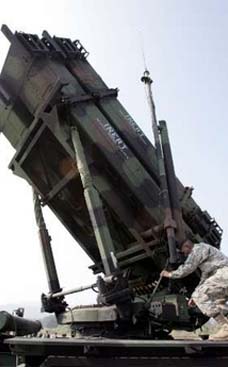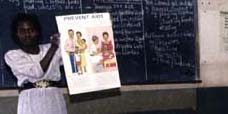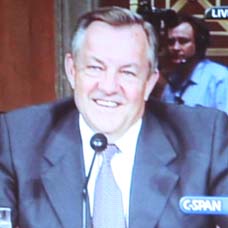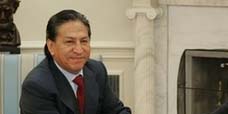2006.10.31: October 31, 2006: Headlines: COS - Morocco: Journalism: COS - Pakistan: Terrorism: Newsday: James Rupert writes: Residents linking U.S. to deadly attack in Pakistan that killed an estimated 80 people in a religious school near the Afghan border
Peace Corps Online:
Directory:
Pakistan:
Peace Corps Pakistan :
The Peace Corps in Pakistan:
2006.10.31: October 31, 2006: Headlines: COS - Morocco: Journalism: COS - Pakistan: Terrorism: Newsday: James Rupert writes: Residents linking U.S. to deadly attack in Pakistan that killed an estimated 80 people in a religious school near the Afghan border
James Rupert writes: Residents link U.S. to deadly attack in Pakistan that killed an estimated 80 people in a religious school near the Afghan border
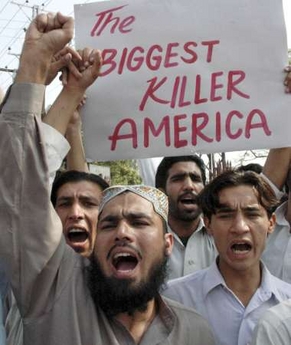
The reported sightings of drones by at least five residents quoted by four local reporters suggests a direct role in the assault by the Central Intelligence Agency, which in the past has operated drones equipped with Hellfire missiles. A State Department spokesman, asked if the United States fired the missiles, said he could not comment on intelligence matters. A CIA spokesman declined to comment. Pakistani officials said the attack was conducted entirely by Pakistani forces, but they barred journalists from entering the area to investigate. Journalist James Rupert, head of Newsday's international bureau in Islamabad, Pakistan began his career abroad as a Peace Corps volunteer, teaching mechanics and welding in Morocco.
James Rupert writes: Residents link U.S. to deadly attack in Pakistan that killed an estimated 80 people in a religious school near the Afghan border
Residents linking U.S. to deadly attack in Pakistan
BY JAMES RUPERT
Newsday Staff Correspondent
October 31, 2006
Caption: Activists of Pakistan Tehrik-e-Insaf (PTI) chant anti-government slogans during a protest in Peshawar November 1, 2006. The activists condemned an army attack on a religious school in the Chenagai area of the Bajaur tribal region bordering Afghanistan. Islamist politicians said the attack on the school was carried out by a U.S. Predator drone aircraft, but Pakistan's military spokesman and a U.S. spokesman in Kabul denied it. REUTERS/Ali Imam (PAKISTAN)
ISLAMABAD, Pakistan -- A day after Pakistan's deadliest attack of the "global war on terror," residents say that U.S. surveillance drones fired at least some of the missiles that killed an estimated 80 people in a religious school near the Afghan border.
The reported sightings of drones by at least five residents quoted by four local reporters suggests a direct role in the assault by the Central Intelligence Agency, which in the past has operated drones equipped with Hellfire missiles. A State Department spokesman, asked if the United States fired the missiles, said he could not comment on intelligence matters. A CIA spokesman declined to comment.
Pakistani officials said the attack was conducted entirely by Pakistani forces, but they barred journalists from entering the area to investigate.
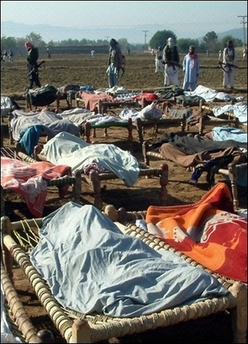
Caption: Armed Pakistani law enforcement officials inspect corpses in Khar. Radical Islamic leaders in Pakistan called for mass protests after around 80 people died in an airstrike on a suspected Al-Qaeda-linked training camp at a religious school(AFP)
Thousands of Pakistanis protested the missile strike in several rallies Tuesday. Speakers declared it was a U.S. attack, with Pakistan participating in the operation in order to hide the Americans' role. A member of Pakistan's parliament who lives nearby said the missiles that destroyed the madrassa in the village of Chingai were fired by a slow-flying surveillance drone that had been circling over the area. Pakistani helicopters arrived about 15 minutes after the main missile strike and fired a number of smaller rockets before leaving, MP Sahibzada Rashid told the newspaper Dawn. His account was paralleled by other residents, Bajaur-based reporters told Newsday.
The attack appeared to have scuttled a peace deal that some Pakistani officials had been negotiating with Bajaur-based militants, including a senior leader killed in the attack. Militants declared Tuesday they had been betrayed by the government and vowed in rallies to launch a holy war in retaliation.
The talks resembled recent Pakistani peace deals with the Taliban movement in Waziristan, a Pakistani region farther south along the border with Afghanistan. "The day before the attack, the political agent [the government's appointed representative in Bajaur] was telling us confidently the deal was ready," said Salim Khan, one of several part-time reporters based in Bajaur who are the only journalists permitted access to the district.
CIA Predator drones fitted with Hellfire missiles have been used in previous attacks against al-Qaida targets in Pakistan's border region. The government of President Pervez Musharraf was hammered by protests in January after a missile strike by at least one Predator killed 13 Pakistanis only a few miles from the site of Monday's attack.
While Musharraf cooperates with the U.S. hunt for al-Qaida figures in Pakistan, any visible U.S. role on its territory is a political liability for him, and his government has made strenuous efforts to hide the missile strikes.
In November, Musharraf's spokesman, Maj. Gen. Shaukat Sultan, tried to portray a U.S. missile attack in Waziristan as an accidental explosion by al-Qaida bomb-makers. After a Pakistani reporter exposed the lie by publishing photos of U.S. missile parts, he was kidnapped and later killed. Tuesday, Sultan denied any participation in the latest attack, telling the Associated Press that the American role was limited to routine intelligence-sharing. Soon after, he re-contacted the AP to say he could not confirm the United States had provided information in the attack.
Links to Related Topics (Tags):
Headlines: October, 2006; COS - Morocco; Journalism; COS - Pakistan; Terrorism
When this story was posted in November 2006, this was on the front page of PCOL:





Peace Corps Online The Independent News Forum serving Returned Peace Corps Volunteers
 | Harris Wofford to speak at "PC History" series
Senator Harris Wofford will be the speaker at the 4th Annual "Peace Corps History" series on November 16 sponsored by the University of Maryland at Baltimore County (UMBC) and the Maryland Returned Volunteers. Previous speakers in the series have included Jack Vaughn (Second Director of the Peace Corps), Scott Stossel (Biographer of Sargent Shriver), and C. Payne Lucas (President Emeritus of Africare). Details on the time and location of the event are available here. |
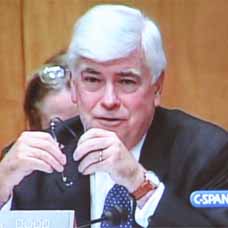 | Chris Dodd's Vision for the Peace Corps
Senator Chris Dodd (RPCV Dominican Republic) spoke at the ceremony for this year's Shriver Award and elaborated on issues he raised at Ron Tschetter's hearings. Dodd plans to introduce legislation that may include: setting aside a portion of Peace Corps' budget as seed money for demonstration projects and third goal activities (after adjusting the annual budget upward to accommodate the added expense), more volunteer input into Peace Corps operations, removing medical, healthcare and tax impediments that discourage older volunteers, providing more transparency in the medical screening and appeals process, a more comprehensive health safety net for recently-returned volunteers, and authorizing volunteers to accept, under certain circumstances, private donations to support their development projects. He plans to circulate draft legislation for review to members of the Peace Corps community and welcomes RPCV comments. |
 | He served with honor
One year ago, Staff Sgt. Robert J. Paul (RPCV Kenya) carried on an ongoing dialog on this website on the military and the peace corps and his role as a member of a Civil Affairs Team in Iraq and Afghanistan. We have just received a report that Sargeant Paul has been killed by a car bomb in Kabul. Words cannot express our feeling of loss for this tremendous injury to the entire RPCV community. Most of us didn't know him personally but we knew him from his words. Our thoughts go out to his family and friends. He was one of ours and he served with honor. |
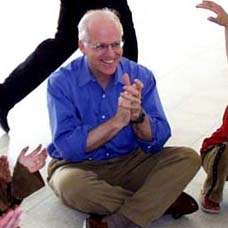 | Chris Shays Shifts to Favor an Iraq Timetable
In a policy shift, RPCV Congressman Chris Shays, long a staunch advocate of the Bush administration's position in Iraq, is now proposing a timetable for a withdrawal of American troops. How Mr. Shays came to this change of heart is, he says, a matter of a newfound substantive belief that Iraqis need to be prodded into taking greater control of their own destiny under the country’s newly formed government. As Chairman of the House Government Reform subcommittee on national security, he plans to draft a timetable for a phased withdrawal and then push for its adoption. A conscientious objector during the Vietnam War who said that if drafted he would not serve, Chris Shays has made 14 trips to Iraq and was the first Congressman to enter the country after the war - against the wishes of the Department of Defense. |
 | Peace Corps' Screening and Medical Clearance
The purpose of Peace Corps' screening and medical clearance process is to ensure safe accommodation for applicants and minimize undue risk exposure for volunteers to allow PCVS to complete their service without compromising their entry health status. To further these goals, PCOL has obtained a copy of the Peace Corps Screening Guidelines Manual through the Freedom of Information Act (FOIA) and has posted it in the "Peace Corps Library." Applicants and Medical Professionals (especially those who have already served as volunteers) are urged to review the guidelines and leave their comments and suggestions. Then read the story of one RPCV's journey through medical screening and his suggestions for changes to the process. |
 | The Peace Corps is "fashionable" again
The LA Times says that "the Peace Corps is booming again and "It's hard to know exactly what's behind the resurgence." PCOL Comment: Since the founding of the Peace Corps 45 years ago, Americans have answered Kennedy's call: "Ask not what your country can do for you--ask what you can do for your country. My fellow citizens of the world: ask not what America will do for you, but what together we can do for the freedom of man." Over 182,000 have served. Another 200,000 have applied and been unable to serve because of lack of Congressional funding. The Peace Corps has never gone out of fashion. It's Congress that hasn't been keeping pace. |
 | PCOL readership increases 100%
Monthly readership on "Peace Corps Online" has increased in the past twelve months to 350,000 visitors - over eleven thousand every day - a 100% increase since this time last year. Thanks again, RPCVs and Friends of the Peace Corps, for making PCOL your source of information for the Peace Corps community. And thanks for supporting the Peace Corps Library and History of the Peace Corps. Stay tuned, the best is yet to come. |
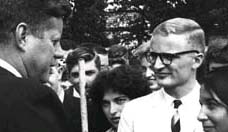 | History of the Peace Corps
PCOL is proud to announce that Phase One of the "History of the Peace Corps" is now available online. This installment includes over 5,000 pages of primary source documents from the archives of the Peace Corps including every issue of "Peace Corps News," "Peace Corps Times," "Peace Corps Volunteer," "Action Update," and every annual report of the Peace Corps to Congress since 1961. "Ask Not" is an ongoing project. Read how you can help. |
Read the stories and leave your comments.

Some postings on Peace Corps Online are provided to the individual members of this group without permission of the copyright owner for the non-profit purposes of criticism, comment, education, scholarship, and research under the "Fair Use" provisions of U.S. Government copyright laws and they may not be distributed further without permission of the copyright owner. Peace Corps Online does not vouch for the accuracy of the content of the postings, which is the sole responsibility of the copyright holder.
Story Source: Newsday
This story has been posted in the following forums: : Headlines; COS - Morocco; Journalism; COS - Pakistan; Terrorism
PCOL35052
93









